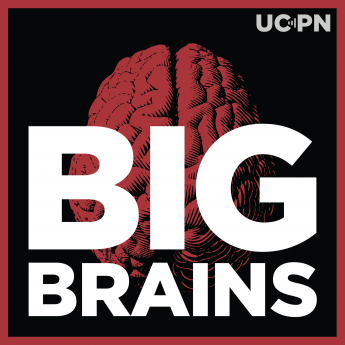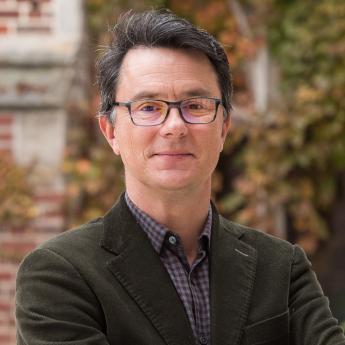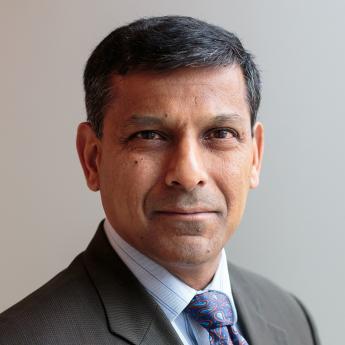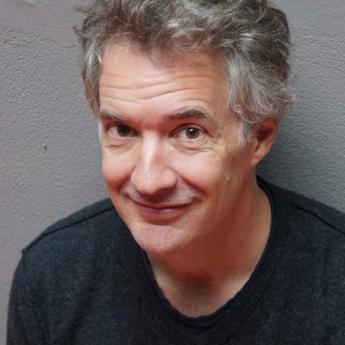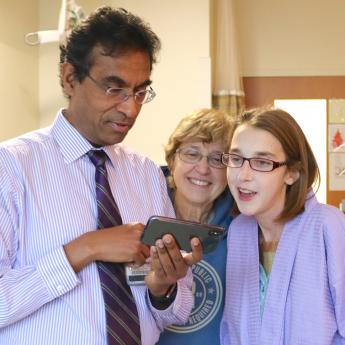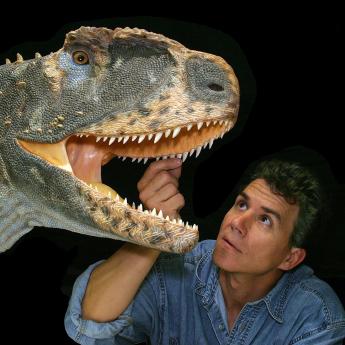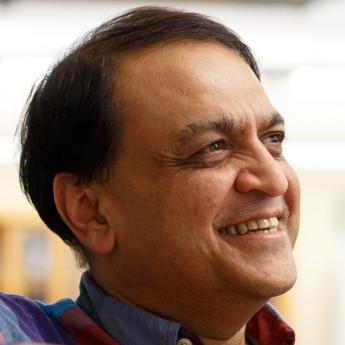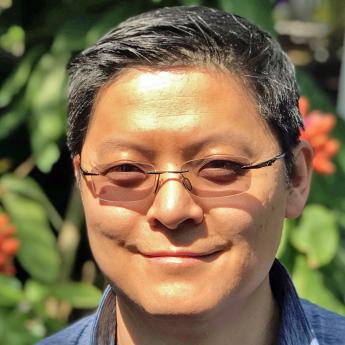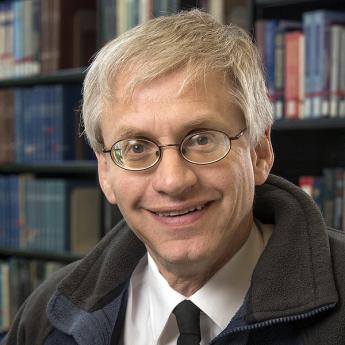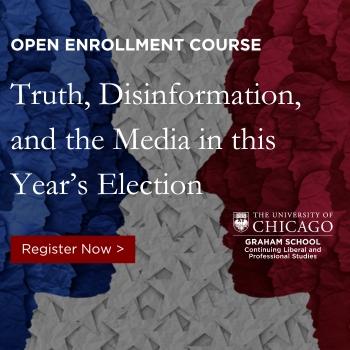Show Notes
They’re perhaps the oldest questions in the science: Why do we die? And could we find a way to live forever? But for decades, anti-aging research was a “backwater” of the scientific community, consider too fanciful and unrealistic. That is until the last few years. Modern advances in biology have taught us a lot about how we age and why we die—could that knowledge help us turn back the clock?
In his new book, “Why We Die: The New Science of Ageing and the Quest for Immortality”, Nobel Prize-winning scientist Venki Ramakrishnan delves into the latest science of aging and investigates the nearly $30 billion dollar longevity industry to separate fact from fiction in our modern quest for immortality.
Subscribe to Big Brains on Apple Podcasts and Spotify.
(Episode published April 18, 2024)
Subscribe to the Big Brains newsletter.
Please rate and review the Big Brains podcast.
Related:
- Award-winning molecular biologist on the consequences of aging — ABC News
- We are driven by the fear of death: A Wknd interview with Nobel laureate Venki Ramakrishnan — Hindustan Times
- Why do we die? The latest on aging and immortality from a Nobel Prize-winning scientist — Yahoo News Canada
- Why Do We Age? Scientists Are Figuring It Out. — The New York Times
- Why we die: Lessons on genes from a lowly worm — Popular Science
- Why We Die by Venki Ramakrishnan review — a cure for death? — The Times
Transcript:
Venki Ramakrishnan: It’s a question that has bothered humanity ever since we were aware of mortality.
Paul Rand: That’s Venki Ramakrishnan, a Nobel Prize-winning structural biologist.
Venki Ramakrishnan: We are the only people who know that we have a certain lifespan. Ever since we discovered that we have worried about it.
Paul Rand: He’s the head of the MRC Laboratory of Molecular biology in Cambridge, England, and the author of a fascinating new book, Why We Die.
Venki Ramakrishnan: Most of our history, there was nothing we could do about it, death and taxes that were just taken for granted. It’s only in the last 40 or 50 years that because of all the advances in biology, we’re understanding really what is the basis for why we age and die. And that’s a foundation for being able to do something about it.
Tape: If you would like to live longer, maybe to 100 and in good health, there is real science now that is claiming this might be possible. A breakthrough in reversing the signs of aging. Researchers say that they found a way to make mice look and even feel younger.
Tape: We want to talk to these mice.
Venki Ramakrishnan: Aging used to be a kind of backwater field. It was not considered serious biology, but now because of modern tools, we’re actually able to make it into harder science. And so more and more mainstream biologists are going into aging research. All of those things have come together to create this, what you might call a moment.
Paul Rand: Today, there are more than 700 biotech companies focused on aging and longevity with the combined market cap of at least $30 billion.
Venki Ramakrishnan: I think these billionaires are used to success, especially these tech billionaires, achieve success very early in life. They think that life is just some sort of software to be hacked, but biology is complicated. And there is this old saying that when they were young, they wanted to be rich, but now they’re rich, they want to be young. And of course, you can’t buy youth, but you can buy aging research. And so they’re investing heavily in aging research.
Paul Rand: With all this investment in hype in the anti-aging industry, it can be difficult to figure out what’s really going on. Many of the top distinguished scientists in the field now have financial stakes in these companies, but Ramakrishnan does not. And with his expertise in structural biology, he may be one of the best experts to tell us what’s real and what the future of anti-aging may look like.
Venki Ramakrishnan: There’s so much interest in aging and there’s also so much hype. So I thought, well, let me look at all the molecular biology because I’m so close to it that I can read the papers and understand what’s absolutely solid and what’s iffy and what’s really unlikely. And I think what my book tries to do really is give people an understanding of the fundamental principles so that when they come across the next big discovery or read about something in some magazine or newspaper or listen to it on a podcast, they can connect it with what they know about what’s going on in ourselves. So it’s really giving them the tools almost for how to live and what to do and how to understand aging.
Paul Rand: Welcome to Big Brains, where we translate the biggest ideas and complex discoveries into digestible brain food. Big Brains, Little Bites from the University of Chicago Podcast Network. I’m your host, Paul Rand. On today’s episode, Why We Die, How We Age, and What We Can Do About It. Big Brains is supported by UChicago’s Online Master of Liberal Arts program, which empowers working professionals to think deeply, communicate clearly, and act purposely to advance their careers, choose from optional concentrations and ethics and leadership, literary studies and tech and society. More at Mla.uchicago.edu. Everything alive ages, everything alive dies. At first glance, this seems to be an immutable fact of nature, but it turns out things aren’t that straightforward.
Venki Ramakrishnan: We’ve wondered about, for example, what makes life spans so different? Sharks and whales, some of them can live several hundred years. A giant tortoise lives 170 plus years, and then at the other end, you have a mayfly that lives for a day and then you have a mouse that lives for two years, but a bat the same size can live for 40 years. So I think the idea that we’re all made of the same material but we age differently, suggests that we could do something about it, and that requires understanding the basis of aging.
Paul Rand: The first step in figuring out what we can do about aging is understanding what it really is. The problem of aging isn’t just one cause and it’s not just a single negative process in our bodies. In fact, many of the causes of aging are the very same things that keep us alive when we’re young.
Venki Ramakrishnan: Biology has a bias. Its main selection is for making sure that the genes we have are passed on. So it’s about the survival of our genes. It doesn’t much care what happens later on in life. So you can see throughout biology, throughout all the causes of aging, there’s always this delicate balance between what’s good for you early in life and what causes aging later. And if you start tinkering with one, you might affect the other.
Paul Rand: Untangling this complicated web of multiple causes starts by figuring out how each strand works, and one of the most fundamental strands is DNA damage.
Venki Ramakrishnan: Absolutely. So if you look at the program of life and of all our cells, it’s encoded in our genes, and that program is there to make all of the proteins that are required for life. We require proteins for almost every function we carry out, including thinking and remembering and fighting infections, not just our muscles. So think of DNA as a long string of letters. They’re chemical letters. DNA uses four kinds of units. And so you can think of it as a long code written in a four-letter alphabet. If you have environmental attack on the DNA, it doesn’t even have to be from carcinogens, it could be just in the natural process of living. It’ll corrupt some of those letters in the DNA.
Paul Rand: Over the course of one single day, 100,000 changes happen to the DNA in each of our cells. In fact, just exposure to water can cause 10,000 transformations.
Venki Ramakrishnan: In other words, some of those elements of DNA will be changed, others will be removed, and sometimes the DNA will be broken, so it’ll be like you have a long sentence and then the sentence is suddenly broken and you don’t know how it ends and you don’t know where the rest of the sentence is. And as we age, those errors build up and this leads to proteins that are the wrong protein. The proteins have mistakes or they’re made at the wrong time, or they’re made in the wrong amounts, or they’re not degraded when they should be. So the program, which is this orchestra of proteins that all have to work together is slowly breaking down. So you get a discordant dysfunctional orchestra if you like.
Paul Rand: But if our DNA is being constantly damaged like this, how do we even make it through a single day, let alone years? The answer is that our body has developed ways to repair DNA. The problem is, this repair response is itself a cause of aging.
Venki Ramakrishnan: One of the big risks if you have DNA damage is cancer. You have over a trillion cells in your body. If a few million of them die, you’re not even going to notice it. In fact, they die all the time. But if one of those cells becomes cancerous, it could kill you. It could kill the whole organism, right? So preventing cancer early on is quite important. So when the cell senses DNA damage, the first thing it does is try to repair the DNA. But if it senses that the damage is too extensive, then it triggers a series of responses which have two possibilities. One is, it just sends a cell into death. It’s called apoptosis. It’s a kind of cellular suicide. So the cell basically dies. The other is that it sends a cell into a state called senescence. These cells are not dead, they’re not even dormant.
They just can’t divide and they can’t carry out their normal function. But one thing they do is they secrete inflammatory compounds because what they’re trying to do is attract the immune system to the site of it. And so it’s a signal to the body to say, “Hey, there’s a problem here. This cell is sending an alarm signal. Go there, deal with it and then you can clear it away.” Now, as we get older, that mechanism itself deteriorates. And so we start accumulating these senescent cells and so we have more and more inflammation as we get older, and that’s one of the major problems with aging.
Paul Rand: Studies have shown that transplanting even small numbers of senescent cells into young mice cause persistent dysfunction.
Venki Ramakrishnan: So the DNA damage response is a curious thing.
Paul Rand: This balance between aging and cancer is one that keeps coming up again and again for researchers. Many of the possible ways to turn back the clock lead to an increased risk of cancer, and many of the ways our body fights cancer lead to aging. In fact, some cancer therapies actually work by inhibiting DNA repair mechanisms.
Venki Ramakrishnan: If you inhibit DNA repair pathways, that’s detrimental to the cancer cell and preferentially it kills off cancer cells. So it’s a paradox. But of course, you can’t inhibit DNA repair for the sake of aging because you really want DNA repair to work well.
Paul Rand: But there are other mechanisms around DNA that may be more promising. One has to do with something called DNA methylation.
Venki Ramakrishnan: With time, our DNA gets additional chemical marks. Some of them are called methyl groups, so they’re called methylation. These additional marks are signals to either inhibit the expression of some genes or sometimes to enhance it. And it turns out, DNA methylation seems to be a better indication of your age. It correlates better, for example, with mortality with late life diseases, than just chronological age. Because we all know there are 70-year-olds who are very spry climb mountains and stuff, and others who are really not in good shape at all. So the places where their DNA is methylated on their genome, that pattern will be different for the two people. There’ll be probably more methylation in the person who has aged more compared to the person who’s aged less. They are inhibiting more of their genes by methylation. And of course, you need many of these genes in order to function.
And people are asking, if we were to reverse the pattern of methylation, could we in fact reverse aging? That’s the theory anyway. But in order to test it, what you would have to do is be able to reverse that methylation and see if somehow the symptoms of aging improved. Okay, that hasn’t quite been done, but people are working on that. And if that works, it would be a way to turn the clock back a little bit. Now, one reason to think that there’s something there, is one place where all our methylation gets erased completely, is when we give birth to a new generation. So when you have a fertilized egg, it goes through a program where all the methylation marks on the original donor cells are erased, and it starts all over again. And that’s why a child born to a forty-year-old woman is not 20 years older than a child born to a twenty-year-old woman. They’re both starting at zero, and it’s because the aging clock has been reset in both of them.
Paul Rand: There’s another piece of our DNA that scientists think play a crucial role in the process of aging, and it may teach us more about how to reverse it. And that piece is the very, very ends of our DNA strands, also known as telomeres.
Venki Ramakrishnan: So our DNA are like a long linear molecule, so they have two ends and in the cell, they’re wrapped up with proteins and form these structures called chromosomes. Now, the thing is that when cells divide, the chromosomes have to be replicated. So you need two where they used to be one, because you’re making two cells out of one. The mechanism for replicating the DNA or copying the DNA has a peculiarity. It can’t copy the very ends of the DNA.
Paul Rand: That’s the telomeres.
Venki Ramakrishnan: So our ends keep getting shorter and shorter. As they get shorter, that structure unravels, and then the cells starts saying, “Oh, there’s a problem here.” And then it sends that cell into senescence, just like as if it were DNA damage.
Paul Rand: And just like with DNA repair, our body has a system to try and fix the shortening telomere problem.
Venki Ramakrishnan: There’s some cells which have to keep dividing like our stem cells. So some cells can’t let the telomeres get shorter, and that special telomere sequence is added by this enzyme called telomerase. It turns out that in most of our end point cells, by end point, I mean let’s say we start with a fertilized egg. The end point would be all the specialized cells that we have, like skin and blood cells and hair, our eye cells and so on, and neurons. Those end point cells, the telomerase is turned off, so they can’t keep on dividing because keeping on dividing is a cancer risk.
Paul Rand: Again, a connection between a possible anti-aging remedy and increased cancer risk.
Venki Ramakrishnan: So we’ve evolved to turn off telomerase, unless we absolutely need them. But cancer cells have figured out how to turn it back on again, and that’s why cancer cells can keep on dividing.
Paul Rand: Now, many researchers are excited about turning telomerase back on as anti-aging mechanisms try to stop our telomeres from shortening. In fact, people with less than normal amount of telomerase have been shown to prematurely develop diseases associated with old age. But of course, if we were just to turn on telomerase, it would increase our risk of cancer.
Venki Ramakrishnan: Other people are trying to tackle this by turning on telomerase just a little bit, so that it can extend your telomeres, so that then as they shorten, you delay senescence. So that’s the idea behind some of these anti-aging companies.
Paul Rand: Now, stress also can affect the telomeres too. Is that right?
Venki Ramakrishnan: Yes. I thought that was a very bizarre connection, but apparently the stress hormone, cortisol, has multiple effects. A lot of times chronic stress is very bad for you, and this stress, oddly enough, actually shortens your telomeres. So it probably is accelerating telomere loss in some way.
Paul Rand: So when you hear people talking about the negative life span effects of stress, there’s a real biological reason for it.
Venki Ramakrishnan: Oh, yeah.
Paul Rand: In the last few years, tens of billions of dollars have been poured into the anti-aging industry to try to use these advances in our biological understanding, to turn back the clock. We’ll get into the specific anti-aging mechanisms being developed after the break.
If you’re getting a lot out of the important research that’s shared on Big Brains, there’s another University of Chicago Podcast Network show that you should check out. It’s called Capital Isn’t. Capital Isn’t uses the latest economic thinking to zero in on the ways that capitalism is and more often isn’t working today. From the debate over how to distribute a vaccine, to the morality of a wealth tax, Capital Isn’t clearly explains how capitalism can go wrong and what we can do about it. Listen to Capital Isn’t, part of the University of Chicago Podcast Network.
Before the break, we talked about the unique abilities of stem cells as they relate to telomeres, but many researchers and companies think that these cells may just be the ultimate key to slowing or even reversing aging.
Venki Ramakrishnan: Many of the ways to attack aging are what I would call slowing down or delaying aging, but stem cells are slightly different. The idea behind that is, it’s a field called cellular reprogramming. This has to do with the fact that if you take a cell from an early embryo, it can produce any kind of cell. It could produce a skin cell or an eye cell or a blood cell or a neuron, but as they keep developing, they specialize into certain kinds of stem cells. So there are stem cells which can only result in new types of blood cells. Other cells can only generate skin or hair, other cells can only generate neurons. What happens with aging is that we need these stem cells even when we’re grown up, because our tissues are constantly being regenerated.
For example, our skin is being replaced quite frequently, and so is our hair as we know, and our blood. You can donate blood and two weeks later, you’ll have remade the blood cells you donated. Other cells, not so much. So neurons turn over very slowly, only a small fraction. A lot of them, we’re stuck with the neurons we have. Heart muscle does not regenerate very well, and that’s why if you damage heart muscle in a heart attack, it’s a serious problem. You can’t just replace it. But if you were able to generate the stem cells that are responsible for regenerating those tissues, you might be able to regenerate as necessary. Now, one problem as we age is our stem cells also age and they go into senescence and they die off. So as we get older, we’re depleting our stem cells and the stem cells we’re left with are what are call clones. They’re descended from just a few strains so they don’t have the same diversity that we were born with.
Now, what cellular reprogramming guys want to do is they want to use a method for which a guy named Yamanaka won the Nobel Prize, which is by introducing four factors that turn on various genes, they’re able to make cells go backwards in this development process, so they could take a fully adult cell and make it go backwards into a stem cell. So this is actually like reversing the clock, but of course, it’s a very complicated thing. Today, if you use Yamanaka factors and turn cells all the way back to what are called pluripotent cells, that is cells that could make any kind of cell, then you get these growths called teratomas, which are kind of cancer.
So the reason that we’ve shut a lot of this ability is again, to prevent cancer early in life. So it does come with all kinds of risks, and also how much do you turn it back and how would you apply it to the body? Because not all our organs age at the same rate. In the same individual, if you look at various markers, their different organs have aged differently in different people. And so how to apply this in a safe and effective way in humans, it’s a big problem. It’s a challenge that these people have to work out. Yes, there’s a lot of promise, and of course, there’s a lot of hype as well. But on the other hand, there is real biology there, and I think it’s going to be an exciting time in the field.
Paul Rand: Another avenue that has many scientists excited revolves around the concept of caloric restriction and the drugs that may be able to induce this state while still allowing us to eat whatever we want. But what does caloric restriction have to do with aging?
Venki Ramakrishnan: In a wide variety of species, it has been found that reducing caloric intake has extended life, at least as compared to an all you can eat. So then the question is, what does this do to our underlying pathways, the biochemical pathways? What does caloric restriction actually do? How does it work? So people found at least two major pathways that are influenced by caloric restriction. One of them, for example, controls protein production, so we don’t make too much protein. During the normal course of life, we’re making proteins and then getting rid of them when we don’t need them anymore, and having them hang around when they’re not needed is also detrimental. So it’s not just producing proteins at the right time. You also have to be able to destroy them at the right time. If the degrading part doesn’t work, then you get a pileup of stuff that you don’t need. So excess protein production is turned down and recycling of garbage is turned up, and both of those things are beneficial for aging. So that’s a pathway called the TOR Pathway.
Paul Rand: When calories are restricted, there are fewer nutrients for cells to use. And when TOR sees this, it can switch off protein synthesis, growth pathways, and turn out cell’s ability to recycle junk, all of which as we’ve seen, are important for aging.
Venki Ramakrishnan: And then people want to know, can we have a drug that does the same thing as caloric restriction?
Paul Rand: Is that rapamycin?
Venki Ramakrishnan: And that’s rapamycin, is one of the more popular drugs that lots of people are studying, because it directly affects one of the major pathways.
Paul Rand: The inhibition of the TOR Pathway by caloric restriction or the drug rapamycin, has also been shown to increase mitochondria. Another reason why it may be helpful for aging.
Venki Ramakrishnan: Mitochondria are a place where the energy units that the cell needs are made. Okay, so you can think of it as they’re the place where the energy currency of the cells make. They’re also involved in a lot of metabolic processes, controlled with the cell.
Paul Rand: Additionally, exercise turns on the same pathways that stimulate mitochondrial production.
Venki Ramakrishnan: Well, of course, rapamycin, originally it was discovered as an antifungal compound. Then it was shown to have antitumor activity. Then it was shown to be an immune suppressor. I mean, it does a lot of things because it is a major pathway, but it’s an immune suppressor, which means you’re more prone to infection, you will heal wounds less effectively. It has a bunch of other side effects as well.
Paul Rand: Rapamycin has been shown to significantly improve health and lifespan in mice. Excitement around the drug has hit such a fever pitch, that Ramakrishnan says, some scientists are quietly self-medicating with it. But he warns the hype is really going past the data at this point.
Venki Ramakrishnan: If you’re perfectly healthy, the bar is higher for you to take it. You’re saying, “I’m going to take rapamycin for 10 years so that at the end of my life, I’ll live an extra 10 years.” Well, that’s a trickier proposition. And so the safety requirements are different. So people have to demonstrate that. And the hope of the rapamycin community is, that they’ll find some sweet spot where it doesn’t have the negative effects like immune suppression, et cetera, but still has the benefits for aging.
Paul Rand: All of these drugs come with trade offs and are incredibly complicated. Could there be a simpler way? Of course, one of the oldest and most straightforward anti-aging stories in human history, revolves around a famous fictional character, Dracula. But recent research has shown he may have actually been onto something with this whole blood thing. When we look back and we look at the science fiction stories of yore, and there was some wealthy industrialist that brings people in, and he replaces his old blood with new blood as a way of extending his life, that actually is not so far-fetched in people’s minds these days, is it?
Venki Ramakrishnan: Oddly enough, there’s some science behind it. And the science behind it is when they connected two animals like an old rat with a young rat, and this experiment’s called parabiosis. It’s basically, they’re sharing their blood supply. It turns out that the old animal benefited by the young blood that was being pumped into it by the young animal. It turned out the young animal also suffered as a result of old blood. And that finding has been reproduced a number of times. And so it seems perfectly good science. So people are then trying to ask, “Well, what is it about young blood that’s different from old blood?” And blood has lots and lots of protein factors, which can do all kinds of things. So they’re trying to figure out what the differences are, and not all the differences might be relevant for this effect.
So they have to figure out which factors that are different, are actually relevant for this beneficial effect. And then they have to find out how they work. Are they activating stem cells? Are they helping with repair? There could be lots of possibilities. That’s a big ongoing area of research. Lots of scientists working on it. There’s some very distinguished ones as well.
Of course, when people saw this in the news media, young blood prevents aging. Then you had a bunch of companies, at least one infamous company that started offering young plasma from that is plasma from the blood of young donors to rich people. And then the FDA tried to shut it down, and they opened under a different name, and it’s still going, I think. There’s this enormous amount of hype. And what this does is they try to jump the gun because there are a group of people who are so worried about aging. They love their lives, they love their active lives, and they’ll do anything, or they’ll do it just to push the envelope. These people are taking advantage of that. Whereas what really needs to happen is people need to understand how this works and then figure out ways of testing it first in animals safely, and then doing proper trials in humans.
Paul Rand: There’s not a person that’s going to be listening to this saying, “You idiot, ask him what we should do today. Make sure he tells you what you should do to extend your life today.” Which is, I’m sure the question you get asked 100 times a day, give me the magical answer, please.
Venki Ramakrishnan: Yeah. Well, yeah. So none of the drugs so far have gone through clinical trials and shown to be effective. So today, the trio of things that you can do yourself is better than any anti-aging medicine on the market. And that is a moderate and healthy diet, including lots of fruits and vegetables. And now exercise has all kinds of things. It induces reaction that helps us repair damage. It even helps with regenerating our mitochondria. So all those things that we discuss about aging, you later learn that exercise has those benefits. Now, a third leg to this trio is sleep, which is very underappreciated, and especially in many Western countries, and I should say particularly in the US, people skimp on sleep. It turns out that sleep is when a lot of the repair and maintenance of our body goes on. And so that trio is very good.
And then there are social things which affect these. For example, reducing stress, socializing, having friendships, et cetera. They’re all free. They don’t have side effects, and as I say, better than anything on the market now. But I want to say, that those three things are also useful for reducing your cholesterol and your blood pressure. And yet, I’m on statins and I’m on anti-blood pressure medication. Why? Because the things I did on my own weren’t quite enough. Things kept creeping up with age. And so I suppose you could say one of the goals of the aging community is to supplement that, to go beyond what you can do yourself. But of course, what you do yourself is what you should start with. And these things hopefully in the future can help you go beyond that.
Paul Rand: The advancements in anti-aging while in their early stages, do hold a lot of promise, and we’re only going to keep taking more steps toward the future when people may live significantly longer. Ramakrishnan says this raises a whole host of ethical questions that we need to figure out before that day comes.
Venki Ramakrishnan: Just like with AI, this is going to have unforeseen social consequences, which is, what would happen if everybody lived to be 100 or everybody lived beyond 120 if they somehow cracked that barrier. And it would result in a very different sort of society. And we need to think about what kind of society we want and how that would end up. And the other is that we already have a huge social disparity. The richest 10% live over a decade, sometimes two decades longer than the poorest 10%.
The things I talked about, exercise, diet, and sleep, those are all things that poor people find it hardest too, because they can’t find a good diet, they have to eat on the run, whatever they can get. They don’t have time to sleep, they’re working two, three jobs. And they don’t have time for exercise often, so everything’s stacked against them. Now, if we now have very sophisticated life extension measures or anti-aging measures, who will get them? If only rich people get them, you’re going to increase the disparity even more. So I think we need to think about socially, how to make these advances available to everyone.
Matt Hodapp: Big Brains is a production of the University of Chicago Podcast Network. We are sponsored by the Graham School. Are you a lifelong learner with an insatiable curiosity? Access more than 50 open enrollment courses every quarter. Learn more at graham.uchicago.edu/bigbrains. If you like what you heard on our podcast, please leave us a rating and review. The show is hosted by Paul M. Rand, and produced by Lea Ceasrine and me, Matt Hodapp. Thanks for listening.
Episode List
How John List Revolutionized Economics by Studying People in the Real World (Ep. 28)
Behind the scenes of policymakers reshaping our society, there are researchers supplying them with answers to our most pressing questions. University of Chicago economist John List is one of those people.
Trump and the Changing Power of the Presidency with William Howell (Ep. 27)
One of the leading scholars on the American presidency gives us insight into the Trump era, the history of impeachment, and the power of the office.
How the Loss of Community Threatens Society with Raghuram Rajan (Ep. 26)
One of the world’s leading economists explains why our communities could hold the answer to many of society’s problems.
The Science of Conspiracy Theories and Political Polarization with Eric Oliver (Ep. 25)
A UChicago political science professor explains how the same force that drives conspiracy theories is intensifying political polarization in our country.
A Modern Medical Miracle with Drs. Valluvan Jeevanandam and Talia Baker (Ep. 24)
A unbelievable coincidence pushes two transplant doctors to attempt a medical feat no one has ever attempted.
An Archaeological Riddle In the Sahara with Paul Sereno (Ep. 23)
A UChicago paleontologist puts aside dinosaur hunting when he discovers a never-before-seen ancient society.
Tiny Creatures, Big Discoveries with Nipam Patel (Ep. 22)
Developmental biologist Nipam Patel explains the importance of studying organisms and the research happening at the Marine Biological Laboratory.
The Hidden Dangers of Artificial Intelligence with Ben Zhao (Ep. 21)
A computer scientist at UChicago explains how artificial intelligence can break crucial systems and be broken itself.
Lessons From Our Country’s Largest School Closing with Eve L. Ewing (Ep. 20)
Eve Ewing explains how race, history and ‘institutional mourning’ intersect in the largest mass public school closing in U.S. history.
Simple Solutions to Address Social Issues with Harold Pollack (Ep. 19)
Prof. Harold Pollack promotes ‘evidence-based optimism’ to tackle our most complex social issues—from finances to crime to health care.

